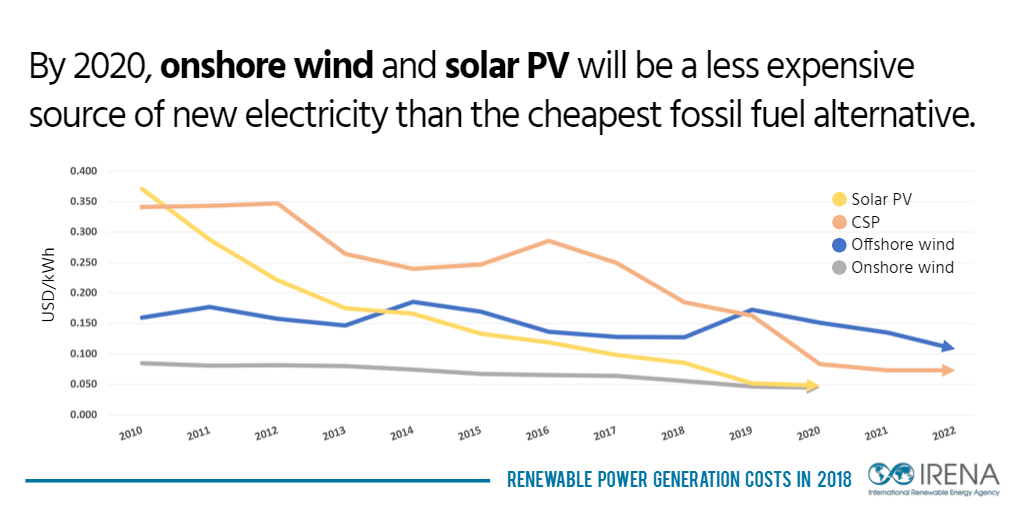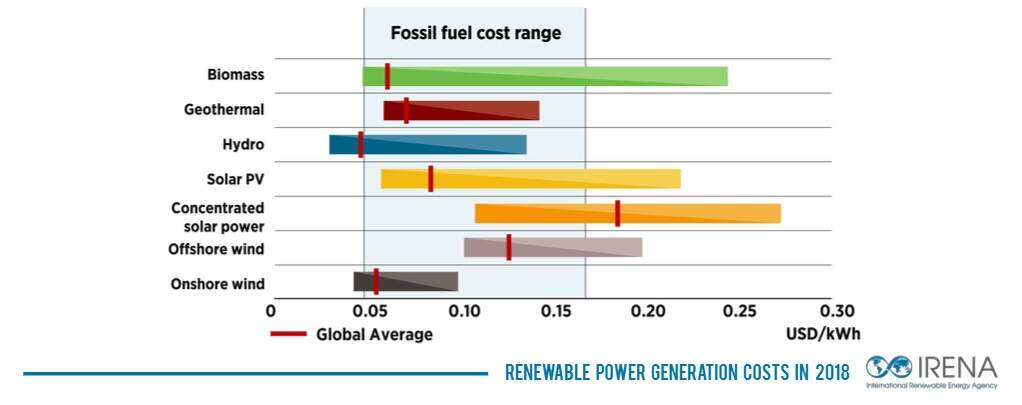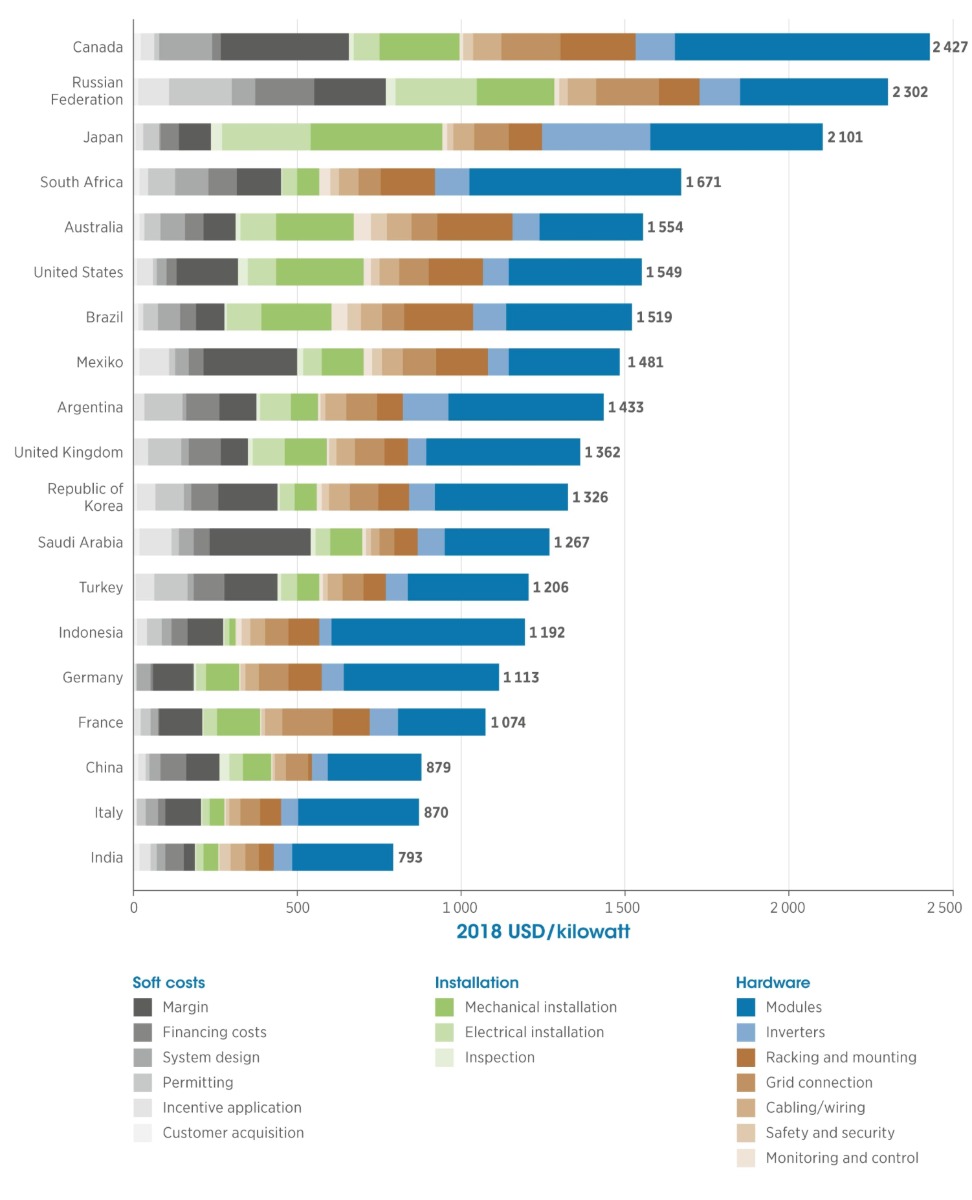Renewable power is the cheapest source of electricity in many parts of the world already today, the latest report from the International Renewable Energy Agency (IRENA) shows. The report contributes to the international discussion on raising climate action worldwide, ahead of Abu Dhabi’s global preparatory meeting for the United Nations Climate Action Summit in September. With prices set to fall, the cost advantage of renewables will extend further, Renewable Power Generation Costs in 2018 says, based on a comprehensive review of data from projects around the world. This will strengthen the business case and solidify the role of renewables as the engine of the global energy transformation.
Costs from all commercially available renewable power generation technologies declined in 2018.The global weighted-average cost of electricity declined 26% year-on-year for concentrated solar power (CSP), followed by bioenergy (-14%), solar photovoltaic (PV) and onshore wind (both -13%), hydropower (-12%), geothermal and offshore wind (both -1%),the report finds.
Continuing cost declines, meanwhile, underline renewable power as a low-cost climate and decarbonisation solution. Within IRENA’s global database, over three-quartersof the onshore wind and four-fifths of the utility-scale solar PV project capacity due to be commissioned in 2020 should provide lower-priced electricity than the cheapest new coal-fired, oil or natural gas option, the report notes.
“Renewable power is the backbone of any development that aims to be sustainable”, said IRENA’s Director-General Francesco La Camera. “We must do everything we can to accelerate renewables if we are to meet the climate objectives of the Paris Agreement. Today’s report sends a clear signal to the international community: Renewable energy provides countries with a low-cost climate solution that allows for scaling up action. “To fully harness the economic opportunity of renewables, IRENA will work closely with our membership and key partners to facilitate on-the-ground solutions and concerted action that will result in renewable energy projects.”
The costs for renewable energy technologies decreased to a record low last year. The global weighted-average cost of electricity from concentrating solar power (CSP) declined by 26%, bioenergy by 14%, solar photovoltaics (PV) and onshore wind by 13%, hydropower by 12% and geothermal and offshore wind by 1%, respectively.
Cost reductions, particularly for solar and wind power technologies, are set to continue into the next decade, the new report finds. According to IRENA’s global database, over three-quarters of the onshore wind and four-fifths of the solar PV projects that are due to be commissioned next year will produce power at lower prices than the cheapest new coal, oil or natural gas options. Crucially, they are set to do so without financial assistance.

Onshore wind and solar PV costs between three and four US cents per kilowatt hour are already possible in areas with good resources and enabling regulatory and institutional frameworks. For example, record-low auction prices for solar PV in Chile, Mexico, Peru, Saudi Arabia, and the United Arab Emirates have seen a levelised cost of electricity as low as three US cents per kilowatt hour (USD 0.03/kWh).

Electrification on the basis of cost-competitive renewables is the backbone of the energy transformation and a key low-cost decarbonization solution in support of the climate goals set out in the Paris Agreement.
Renewable energy has become an increasingly competitive way to meet new power generation needs. This comprehensive cost study from the International Renewable Energy Agency (IRENA) highlights the latest trends for each of the main renewable power technologies. Released ahead of high-profile United Nations energy and climate discussions, Renewable Power Generation Costs in 2018 draws on the latest cost and auction price data from projects around the world.
Costs from all commercially available renewable power generation technologies declined in 2018.The global weighted-average cost of electricity declined 26% year-on-year for concentrated solar power (CSP), followed by bioenergy (-14%), solar photovoltaic (PV) and onshore wind (both -13%), hydropower (-12%), geothermal and offshore wind (both -1%),the report finds.
Continuing cost declines, meanwhile, underline renewable power as a low-cost climate and decarbonisation solution. Within IRENA’s global database, over three-quartersof the onshore wind and four-fifths of the utility-scale solar PV project capacity due to be commissioned in 2020 should provide lower-priced electricity than the cheapest new coal-fired, oil or natural gas option, the report notes.
Among other findings:
- Onshore wind and solar PV power are now, frequently, less expensive than any fossil-fuel option, without financial assitance.
- New solar and wind installations will increasingly undercut even the operating-only costs of exisitng coal-fired plants.
- Low and falling technology costs make renewables the competitive backbone of energy decarbonisation – a crucial climate goal.
- Cost forecasts for solar PV and onshore wind continue to be revised as new data emerges, with renewables consistently beating earlier expectations.
Along with reviewing cost trends, the report analyses cost components in detail. The report draws on IRENA’s cost database of around 17 000 renewable power generation projects and 9 000 auction and power purchase agreements for renewable power.
Sample figure
Utility-scale solar PV:
Total installed costs in 2018 by component and country

Read IRENA’s report “Renewable Power Generation Costs in 2018”.
Read IRENA’s report “Global Energy Transformation: A Roadmap to 2050”.


